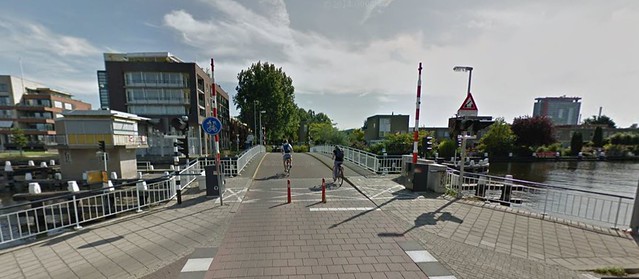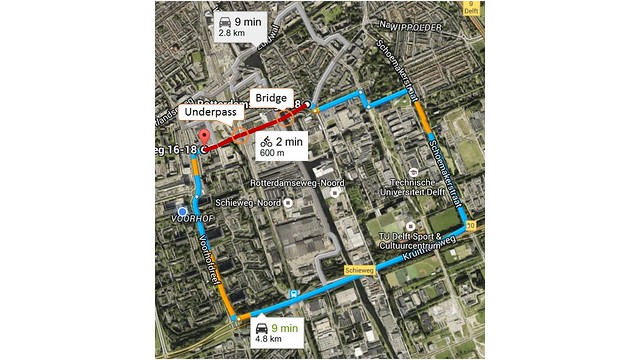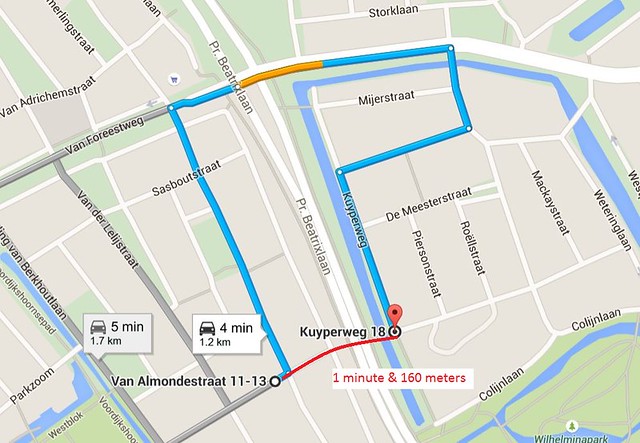Group 1: Tyler Wong, Molly McNally, Matt Duranleau, Caroline Lucas, Ryan Cullen, Vanessa Sandoval
Abstwoudsebrug is a small bicycle and pedestrian bridge that connects the local street Abstwoudseweg with a similar street Lausbergstraat, a few hundred feet west of the edge of TU Delft’s campus. It features a generously wide (about 12 ft) two-way cycle track as well as a sidewalk only a few feet wide on one side. Because it serves mainly as a bike bridge, it was designed to be low to the level of the ground making it possible for bicyclists to climb the incline without stopping or walking their bikes. While this trait is extremely beneficial for bicyclists and pedestrians, it means that this swing bridge must turn quite often in order to let boats any taller than a few feet down the canal. This leads to a relatively frequent waiting period that because of the high volume of bike traffic can cause a buildup of potentially hundreds of bikes on either side of the bridge. This, as well as possible low-speed bike-pedestrians conflicts due to the sidewalk being on only one side of the bridge, are small prices to pay for the huge advantage bicyclists/pedestrians are gaining over car travel due to the bridge shortcut.
The following map illustrates the route which cars in the area have to take to reach one side of the canal from the other, emphasizing the time and distance advantage that bikes are given through the creation of this bridge. The map also takes into account the nearby underpass to the train tracks built along the same road, named Abstwoudsetunnel. What made this project so expensive was the need to do underground work, but the design of a bike tunnel rather than a train track crossing eliminated any kind of potential conflict or danger between these two modes.Combining this tunnel with the bike-ped bridge significantly shortened the time it took to get between the two neighborhoods separated by the canal and train tracks, two strong parallel boundaries.
The short bicycle and pedestrian bridge Hoventunnel accomplishes a similar task in increasing connectedness of bikeways while discouraging automobile traffic, but in the context of quiet, more woonerf-like streets. As the street it passes underneath is a busy 4-lane highway, this tunnel is the only practical way that bikers and walkers can get through to the rest of this community without riding at least 1.2 km out of their way.
In our opinion, where the underpass relates to a freeway or rail line, the cost of building the underpass should be borne by the highway/rail program. When a new highway or railroad is built, it acts as a wall cutting off what is located on either side of the new infrastructure. Before the freeway or railroad is built, cyclists and pedestrians were free to travel nearly where ever they wanted to. There was no wall dividing a community in half. However, after the new freeway or railroad is built, the mobility of the cyclists and pedestrians becomes severely limited. It is not the fault of the cyclists that they can’t get from Point A to Point B. It is the fault of the freeway or the railroad. In the case where a new crossing wants to be built under an existing rail line or highway, the existing infrastructure still acts as a wall. If the rail line or highway was not there, the cost to build the bike facility would be significantly cheaper. The cost of the facility goes up drastically just because there is a freeway or railroad in the way. Therefore, in an ideal world it should be up to the highway or rail program to pay for a new crossing where necessary. Since they act as barriers, the railroads and highways are the reason that an expensive crossing needs to be built.
However, in modern politics we understand that rail and highway programs are not generally offering to pay for new bike crossings. It is not in their best interest to invest in this expensive new infrastructure, as it does not directly benefit freeway drivers or train operators. Therefore, in the real world the best way to pay for these programs should be through a jointly-funded program. The bike program and the rail/highway program should offer to split the cost of the new crossing, because otherwise it would never be built.


